K.O. Victoria Lieu was a Chinese entomologist known for her studies of Aegeriidae (mulberry borers) and Cerambycidae (citrus borers). [1]
K.O. Victoria Lieu was a Chinese entomologist known for her studies of Aegeriidae (mulberry borers) and Cerambycidae (citrus borers). [1]

Fraxinus, commonly called ash, is a genus of flowering plants in the olive and lilac family, Oleaceae. It contains 45–65 species of usually medium to large trees, mostly deciduous, though a number of subtropical species are evergreen. The genus is widespread across much of Europe, Asia, and North America.

The Crambidae are the grass moth family of lepidopterans. They are variable in appearance, the nominal subfamily Crambinae taking up closely folded postures on grass stems where they are inconspicuous, while other subfamilies include brightly coloured and patterned insects which rest in wing-spread attitudes.

Buprestidae is a family of beetles known as jewel beetles or metallic wood-boring beetles because of their glossy iridescent colors. Larvae of this family are known as flatheaded borers. The family is among the largest of the beetles, with some 15,500 species known in 775 genera. In addition, almost 100 fossil species have been described.

The emerald ash borer, also known by the acronym EAB, is a green buprestid or jewel beetle native to north-eastern Asia that feeds on ash species. Females lay eggs in bark crevices on ash trees, and larvae feed underneath the bark of ash trees to emerge as adults in one to two years. In its native range, it is typically found at low densities and does not cause significant damage to trees native to the area. Outside its native range, it is an invasive species and is highly destructive to ash trees native to Europe and North America. Before it was found in North America, very little was known about emerald ash borer in its native range; this has resulted in much of the research on its biology being focused in North America. Local governments in North America are attempting to control it by monitoring its spread, diversifying tree species, and through the use of insecticides and biological control.
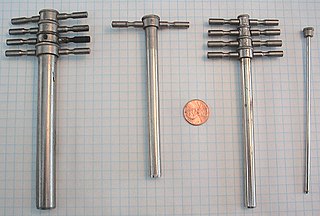
A cork borer, often used in a chemistry or biology laboratory, is a metal tool for cutting a hole in a cork or rubber stopper to insert glass tubing. Cork borers usually come in a set of nested sizes along with a solid pin for pushing the removed cork out of the borer. The individual borer is a hollow tube, tapered at the edge, generally with some kind of handle at the other end.

Beauveria bassiana is a fungus that grows naturally in soils throughout the world and acts as a parasite on various arthropod species, causing white muscardine disease; it thus belongs to the entomopathogenic fungi. It is used as a biological insecticide to control a number of pests, including termites, thrips, whiteflies, aphids and various beetles. Its use in the control of bedbugs and malaria-transmitting mosquitos is under investigation.

Fraxinus pennsylvanica, the green ash or red ash, is a species of ash native to eastern and central North America, from Nova Scotia west to southeastern Alberta and eastern Colorado, south to northern Florida, and southwest to Oklahoma and eastern Texas. It has spread and become naturalized in much of the western United States and also in Europe from Spain to Russia.

The Pyraloidea are a moth superfamily containing about 16,000 described species worldwide, and probably at least as many more remain to be described. They are generally fairly small moths, and as such, they have been traditionally associated with the paraphyletic Microlepidoptera.

The term woodboring beetle encompasses many species and families of beetles whose larval or adult forms eat and destroy wood. In the woodworking industry, larval stages of some are sometimes referred to as woodworms. The three most species-rich families of woodboring beetles are longhorn beetles, bark beetles and weevils, and metallic flat-headed borers. Woodboring is thought to be the ancestral ecology of beetles, and bores made by beetles in fossil wood extend back to the earliest fossil record of beetles in the Early Permian (Asselian), around 295-300 million years ago.
The jig borer is a type of machine tool invented at the end of World War I to enable the quick and precise location of hole centers. It was invented independently in Switzerland and the United States. It resembles a specialized species of milling machine that provides tool and die makers with a higher degree of positioning precision (repeatability) and accuracy than those provided by general machines. Although capable of light milling, a jig borer is more suited to highly accurate drilling, boring, and reaming, where the quill or headstock does not see the significant side loading that it would with mill work. The result is a machine designed more for location accuracy than heavy material removal.

The European corn borer, also known as the European corn worm or European high-flyer, is a moth of the family Crambidae which includes other grass moths. It is a pest of grain, particularly maize. The insect is native to Europe, originally infesting varieties of millet, including broom corn. The European corn borer was first reported in North America in 1917 in Massachusetts, but was probably introduced from Europe several years earlier. Since its initial discovery in the Americas, the insect has spread into Canada and westward across the United States to the Rocky Mountains.

Casey Patrick Borer is an American former professional ice hockey player. He played in the National Hockey League (NHL) for the Carolina Hurricanes.

An increment borer is a specialized tool used to extract a section of wood tissue from a living tree with relatively minor injury to the plant itself. The tool consists of a handle, an auger bit and a small, half circular metal tray that fits into the auger bit; the last is usually manufactured from carbide steel. It is most often used by foresters, researchers and scientists to determine the age of a tree. This science is also called dendrochronology. The operation enables the user to count the rings in the core sample, to reveal the age of the tree being examined and its growth rate. After use the tool breaks down: auger bit and extractor fit within the handle, making it highly compact and easy to carry.
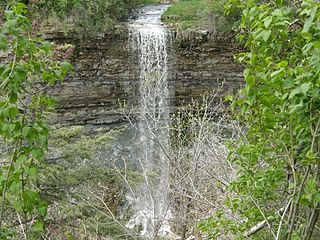
Borer's Falls is a 15-metre-high (49 ft) ribbon-style waterfall found in the Borer's Falls Conservation Area in Dundas, Hamilton, Ontario, Canada. Its source is Borer's Creek. A very picturesque waterfall featured on many Hamilton waterfall postcards over the years. Named after the Borer family who ran a sawmill for over a century. This mill was the lifeblood of the village of Rock Chapel. Also known as Rock Chapel Falls. The area is a hiker's haven and also an ice-climbing destination in the winter when the weather is cold enough to freeze the Falls.
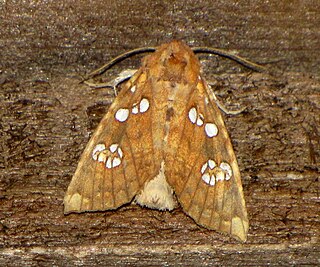
Papaipema is a genus of moths of the family Noctuidae. The genus was erected by John B. Smith in 1899.

Busseola fusca is a species of moth that is also known as the maize stalk borer. It is known from Ethiopia.
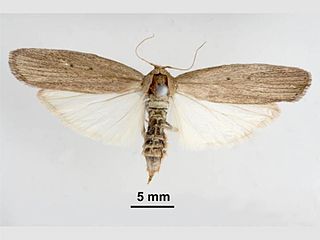
Eldana is a genus of moths of the family Pyralidae containing only one species, the African sugar-cane borer, which is commonly found in Equatorial Guinea, Ghana, Mozambique, Sierra Leone and South Africa. Adults have pale brown forewings with two small spots in the centre and light brown hindwings, and they have a wingspan of 35mm. This species is particularly relevant to humans because the larvae are a pest of the Saccharum species as well as several grain crops such as sorghum and maize. Other recorded host plants are cassava, rice and Cyperus species. When attacking these crops, E. saccharina bores into the stems of their host plant, causing severe damage to the crop. This behavior is the origin of the E. saccharrina's common name, the African sugar-cane borer. The African sugar-cane borer is a resilient pest, as it can survive crop burnings. Other methods such as intercropping and parasitic wasps have been employed to prevent further damage to crops.
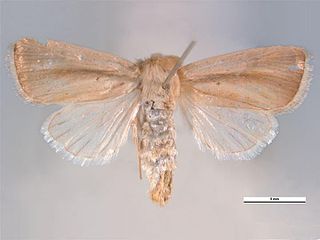
Sesamia inferens, the Asiatic pink stem borer, gramineous stem borer, pink borer, pink rice borer, pink rice stem borer, pink stem borer, purple borer, purple stem borer or purplish stem borer, is a moth of the family Noctuidae. The species was first described by Francis Walker in 1856. It is found from Pakistan, India, Sri Lanka, Myanmar to Japan and the Solomon Islands. A polyphagous species, it is a major pest in many crops worldwide.
Dorinda Keenan Borer is an American businesswoman and former member of the West Haven Board of Education. Borer is a Democratic member of the Connecticut House of Representatives who serves District 115.
The 2022 Nebraska Secretary of State election will be held on November 8, 2022, to elect the Secretary of State of Nebraska. Incumbent Republican Bob Evnen is running for re-election. No Democratic candidates filed against him.